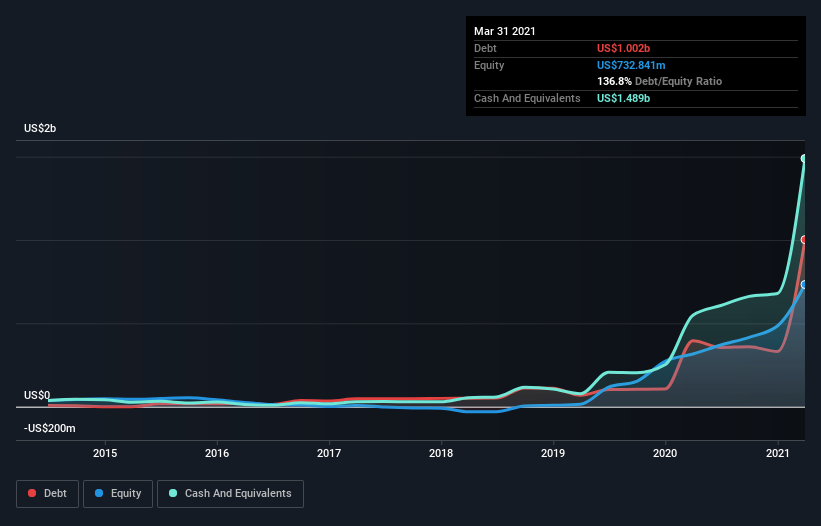These 4 Measures Indicate That Enphase Energy (NASDAQ:ENPH) Is Using Debt Safely
David Iben put it well when he said, 'Volatility is not a risk we care about. What we care about is avoiding the permanent loss of capital.' So it seems the smart money knows that debt - which is usually involved in bankruptcies - is a very important factor, when you assess how risky a company is. As with many other companies Enphase Energy, Inc. (NASDAQ:ENPH) makes use of debt. But should shareholders be worried about its use of debt?
What Risk Does Debt Bring?
Debt and other liabilities become risky for a business when it cannot easily fulfill those obligations, either with free cash flow or by raising capital at an attractive price. If things get really bad, the lenders can take control of the business. While that is not too common, we often do see indebted companies permanently diluting shareholders because lenders force them to raise capital at a distressed price. Of course, the upside of debt is that it often represents cheap capital, especially when it replaces dilution in a company with the ability to reinvest at high rates of return. When we think about a company's use of debt, we first look at cash and debt together.
Check out our latest analysis for Enphase Energy
What Is Enphase Energy's Net Debt?
As you can see below, at the end of March 2021, Enphase Energy had US$1.00b of debt, up from US$395.8m a year ago. Click the image for more detail. But it also has US$1.49b in cash to offset that, meaning it has US$486.8m net cash.
A Look At Enphase Energy's Liabilities
The latest balance sheet data shows that Enphase Energy had liabilities of US$344.5m due within a year, and liabilities of US$1.12b falling due after that. Offsetting these obligations, it had cash of US$1.49b as well as receivables valued at US$255.4m due within 12 months. So it actually has US$283.1m more liquid assets than total liabilities.
Having regard to Enphase Energy's size, it seems that its liquid assets are well balanced with its total liabilities. So while it's hard to imagine that the US$16.3b company is struggling for cash, we still think it's worth monitoring its balance sheet. Succinctly put, Enphase Energy boasts net cash, so it's fair to say it does not have a heavy debt load!
In addition to that, we're happy to report that Enphase Energy has boosted its EBIT by 45%, thus reducing the spectre of future debt repayments. The balance sheet is clearly the area to focus on when you are analysing debt. But it is future earnings, more than anything, that will determine Enphase Energy's ability to maintain a healthy balance sheet going forward. So if you want to see what the professionals think, you might find this free report on analyst profit forecasts to be interesting.
Finally, a business needs free cash flow to pay off debt; accounting profits just don't cut it. While Enphase Energy has net cash on its balance sheet, it's still worth taking a look at its ability to convert earnings before interest and tax (EBIT) to free cash flow, to help us understand how quickly it is building (or eroding) that cash balance. Happily for any shareholders, Enphase Energy actually produced more free cash flow than EBIT over the last three years. There's nothing better than incoming cash when it comes to staying in your lenders' good graces.
Summing up
While it is always sensible to investigate a company's debt, in this case Enphase Energy has US$486.8m in net cash and a decent-looking balance sheet. The cherry on top was that in converted 108% of that EBIT to free cash flow, bringing in US$226m. So we don't think Enphase Energy's use of debt is risky. When analysing debt levels, the balance sheet is the obvious place to start. However, not all investment risk resides within the balance sheet - far from it. For example - Enphase Energy has 6 warning signs we think you should be aware of.
If, after all that, you're more interested in a fast growing company with a rock-solid balance sheet, then check out our list of net cash growth stocks without delay.
This article by Simply Wall St is general in nature. It does not constitute a recommendation to buy or sell any stock, and does not take account of your objectives, or your financial situation. We aim to bring you long-term focused analysis driven by fundamental data. Note that our analysis may not factor in the latest price-sensitive company announcements or qualitative material. Simply Wall St has no position in any stocks mentioned.
Have feedback on this article? Concerned about the content? Get in touch with us directly. Alternatively, email editorial-team (at) simplywallst.com.

